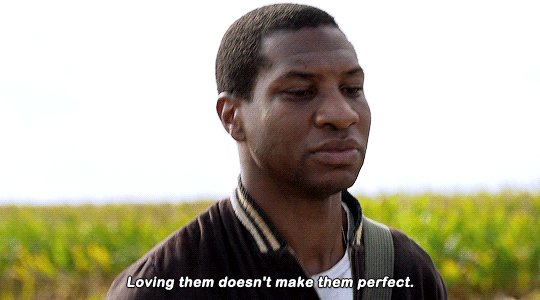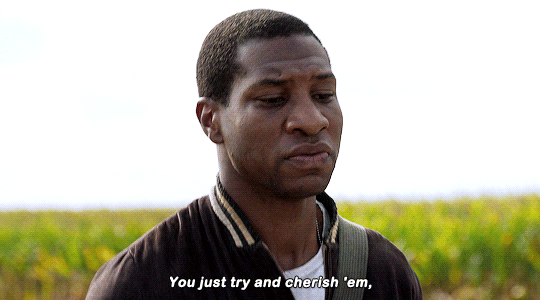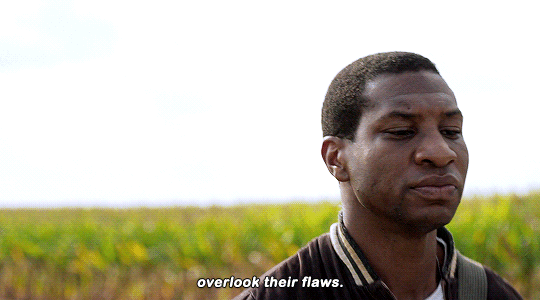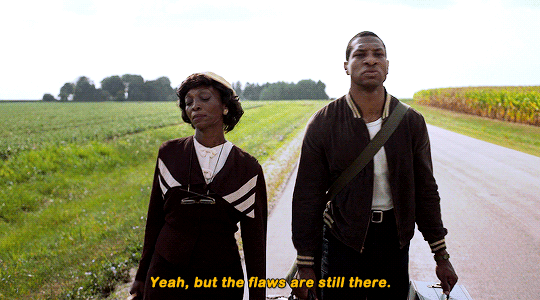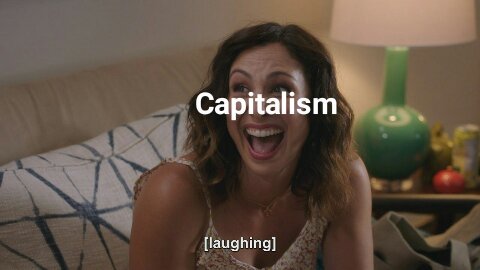Text
alan moore and the ethics of superhero movies
Controversial take, but Alan Moore might need to actually be quiet, forever. I don’t say this because I’m a triggered normie who likes my superhero content, I say this as a media critic about to get a degree in media that he's crusty and old and seems to think that the only reason people SHOULD consume media is to Become More Aware. (Mr. Moore, I am painfully aware at all times of how bad the world is if I want to watch Paul Rudd in a well-fitted super suit riding an ant that’s goddamn my prerogative.) Art can exist to fulfill a lot of different purposes, to make you happy or to make you think, its all valid, but I do think there's a tendency among Intellectuals to assume that positive media is inherently "stupid" media and I find that incredibly annoying.
For the uninitiated, Alan Moore is the creator of the Watchmen and the incredibly famous Batman comic The Killing Joke, which is to say he’s spent his career writing fairly brutal stories. Well written stories, but brutal stories with an overall generally misanthropic tone. The Watchmen is a more relevant one to discuss-- it being essentially a “what if superheroes were real” story set in an alternate America in which the Watchmen act as unaccountable government stooges. His version of Batman, a character named Rorschach, is a raging right-wing racist misogynist. Maybe an apt conversion to make, considering the right’s love for the idea of the vigilante-- though in real life, they tend to prefer the Punisher over Batman.
I’m not saying that Watchmen styled critique of genres is a bad thing inherently. Watchmen is one of the most beloved comics of all time by critics for a reason. But in the current climate of America, I can’t help but wonder if we place too little value on media that uplifts us rather than “intellectual” media that makes you feel bad about the world. Being aware of the horrors of existence and capitalism and everything else is all well and good, but if that’s all you’re getting and all you’re thinking about, then I think it’s impossible for despair not to set in.
And it’s hard to do necessary work towards change if all you have is despair. Maybe it’s immature of me, but I think that stories are a vital part of hte human spirit. They’re how we can process and understand things, and they can be places from which we draw strength to continue going.
I guess this is a long-winded way to say I didn’t like the Watchmen.
0 notes
Text
did you guys watch the debate
I watched the debate. I have regrets.
0 notes
Text
i don’t know what to say
Ruth Bader Ginsberg passed away. I don’t have a lot to write. I can only really reflect on the constant horror of being a girl in America. It’s surreal seeing the reactions of everyone online at once. The dawning horror of it all, knowing that it’s going to make this fraught election even worse.
In 2016, the Republicans delayed Obama’s Supreme Court nomination for 8 whole months, never confirming his judge. I doubt if the House democrats will have the same sense of urgency. Over and over again, I feel like American politics are just theatre for the benefit of the actors in it, and the people don’t factor in even slightly.
A relevant video.
youtube
0 notes
Note
What’s your typical day like?
i wake up. i malfunction. i call it a day
155K notes
·
View notes
Text
mdia 4176 entry 1
It’s funny, coming back here. In such a short time, life has changed so much. A pandemic, the elections, a serious chronic injury that’s rendered me unable to create art for an extended period. The only sure thing about life is that it changes.
That’s not even to talk about the way that technology changes. I mean, here I am on tumblr, and no one uses this anymore.
I’m what you’d call an “online person”.

Never having been very popular, I fled to the internet for socialization and as a creator of stories and art, the consumption and critique of media is sort of my bread and butter. More than that, I’m very much a part of online communities formed around interests in shows and video games and books and what have you-- colloquially, fandom.
Much of fandom life in recent years involves a constant re-evaluation of one’s own relationship to the media that they consume. This isn’t a bad thing-- in fact, it’s a good thing. Mostly. Although most fandoms (at least the ones I associate myself with) are deeply left-leaning, they often struggle with a sort of strange moral puritanism mixed with a strong in-group/out-group mentality-- you see this sort of behavior at its very worst in what’s referred to as “cancel culture” (the actual cancel culture that exists and not the one that Republicans are constantly crying wolf about). It’s incredibly hard to explain, but I’ll try to by way of some drama that went down very recently.
People who take their media very seriously and participate heavily in online fandom frequently equate one’s media habits and tastes with one’s moral character-- it’s often difficult to find criticism of media anymore that’s not making some sort of political-moral judgment on the text. These critiques are then extrapolated into into “everything and the kitchen sink” style conclusions about real people that often ignore nuance completely in favor of black or white “a person is either good or bad” statements.
This type of thinking tends to promote a sort of media consumption that prioritizes the “purity” of the media as its most essential feature. To this end, you’ll find that a lot of the fans of children’s cartoons that focus on representation (Steven Universe, The Owl House, She-Ra) are often the most zealous, puritanical types. However, this results in an unhealthy relationship between the audience and creators of these shows. In most cases, the showrunners are easily accessible through social media, most often twitter. This accessibility is mostly a good thing-- it’s a cycle of engagement that makes fans feel heard and creators feel appreciated. However, it creates an environment in which these creators are just as easily accessible when something goes downhill, and the resulting dog-piling is never a pretty sight.
She-Ra show runner Noelle Stevenson, herself a member of the LGBT community, recently came under fire for an insensitive joke relating to a black character in the show. The character’s name is Bow, who has a lot of siblings. A running joke among the showrunners was that Bow’s siblings all had rhyming names-- Woe, Oboe, Gogh, et cetera-- and one of them was named Sow, and the accompanying drawing was essentially Bow with a straw farmer’s hat and a little thingie of wheat in his mouth. The imagery was obviously upsetting to many black viewers, and those feelings are very valid.
However, the tone of the conversation surrounding Noelle, who was quick to give a heartfelt apology, was anything but constructive. The entirety of She-Ra was condemned for this small mistake-- the purity of the property was forever “tainted”. Many of the things the show accomplished-- portrayal of trans characters, of lesbian relationships, of people of color, of autism-- were summarily dismissed because, in the lens of this fandom culture, something can only be “good” or “bad”.
It’s frustrating to see this cycle repeat itself-- an accessible creator makes an earnest effort to create diverse media, only to be summarily obliterated when they make any sort of mistake. Meanwhile Hollywood, untouchable by twitter, continues to produce stale and often times problematic media, and very little critique is actually done of these products.
Creating diverse media will always be worth the risk of making a mistake-- you have to slip up sometimes in order to learn, and that’s okay. But it’s disheartening to see marginalized communities quicker to tear each other down than to build each other up-- to be destructive rather than constructive. There’s a very “lizard brain” appeal to cancelling people-- it’s perhaps the closest modern equivalent to throwing rotten tomatoes at someone in a stockade or rubbernecking at a public execution. It’s a form of hierarchical thinking-- of posturing-- it necessitates the stifling of empathy, and encourages ego.
Calling this behavior “puritanical” feels accurate in many ways-- puritans are conservative by nature, and I do consider this sort of behavior to be...well, antithetical to what any leftist’s praxis should actually be.
0 notes
Text
the matrix 2 electric boogaloo

Y’all ever heard of too much of a good thing?
Let’s...um, talk about what I liked first?
what i liked
The Wachowskis are guilty of a lot but they aren’t guilty of making the same movie twice. For better or worse, the Matrix Reloaded and Revolutions are...um, different? I appreciate that the movies go off the rails about the Chosen One stuff with the machines being part of it and umm...it’s cool that Neo isn’t really in the climax of the second one so that Trinity and Morpheus could flex. Some of the new characters are cool, but underutilized, Niobe especially.
They take the Chosen One narrative and twist it sideways which is a cool idea. The fight choreography is tight per the usual. There’s a lot of good reincorporation of imagery in Reloaded re: the idea of cycles, the clock especially. The CGI mostly stands up, but a lot of it ends up looking rubbery and weird. There were multiple moments where I laughed out loud at these movies where I did not mean to and I felt bad about it afterwards. Some of the imagery can be straight up H.R. Geiger-y which is nice (the xenomorph is my girlfriend I love Alien).
matrix reloaded
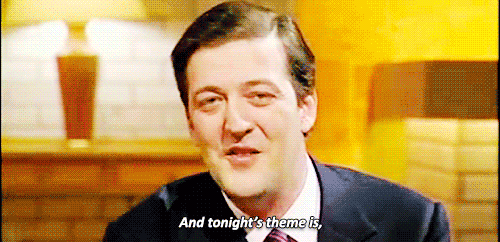
So let’s say that The Matrix: Reloaded is a movie about determinism, which is basically the philosophy of cause and effect that the past directly leads to the future and there’s an element of immutability to it. The movie opens on a scene that’s chronologically late in the movie’s events where Trinity gets shot, emphasizing that there’s kind of an unbreakable cycle of time and you can’t actually change anything. This is a cool philosophical idea with interesting story leads, but what it amounts to in this movie is that you spend a lot of time going “why are they doing this? when is anything going to actually happen?” and listening to the characters wax philosophical about it in between every action set piece.
Neo only really does 4 things in this movie that has an over two hour long run time. He finds the Oracle, he finds the Keymaker, he goes to the Source, and he rescues Trinity, and everything else is either beating you over the head with The Theme, or it’s a fight scene. Now, this wouldn’t necessarily be bad if the movie hadn’t spent its entire runtime telling you that Neo has no agency and nothing he does matters-- the choice of saving Zion or saving Trinity could have had genuine weight, but every character treats it like a foregone conclusion-- and if the rest of the movie hadn’t been about Neo’s lack of agency, that could’ve been a sweet moment showing how much Neo cares about Trinity.
Anyways, there’s a lot of other things that are’t good here. The CGI hasn’t aged particularly well in a lot of spots, they don’t lend enough interest to what Agent Smith’s arc even is because he’s also busy talking about determinism. They kind of damsel Trinity, which is annoying. They add a lot of characters that don’t really add anything to the world of the Matrix. The Christian mythology is hamfisted (the Merovingian is named for the protectors of a book (the Keymaker) that led to the location of The Holy Grail (the Source)) and the Jesus imagery associated with Neo has only been outdone by Zac Snyder’s embarrassingly on the nose Man of Steel shots.
Reloaded sort of “undoes” the entire weight of the first movie because making Neo’s rebellious Chosen One narrative part of the system makes you go “what was the point then?” and not in like, a fun to watch or think about way. Then the movie just sort of ends, and gives you that annoying “to be concluded” tag.
the matrix revolutions

I have to keep talking about themes and philosophy I’m sorry. So a postmodernist daddy named Jean Baudillard wrote a book in 1981 called Simulacra and Simulation, which the Matrix trilogy references many times both by just showing the book and Morpheus line about “The Desert of the Real”. TL;DR the Desert of the Real refers to Baudillard’s critique of postmodernist semiotics in which reality is replaced with shittier symbols of the original thing. Simulacra is his term for signs that have no tangible relation with “the real”, but pretend to. When a lot of simulacra come together, they form a simulation-- and when a lot of simulations get together, we end up with a “virtual reality”; when these simulations become more real than reality and begin to dictate it, we get hyperreality. The entire concept of The Matrix basically owes itself to this theory.
Baudillard actually wasn’t much a fan of the Wachowskis work because he took issue with the Wachowskis drawing such clear lines of distinction between the virtual and the real, and to the Wachowskis credit, they totally abandon that idea in Revolutions by giving Neo like, superpowers in the real world. I suppose the implication is that the virtual is not separate from the real, but more like a “layer” of the real that Neo taps into. That’s what I’m using to justify the superpowers, anyways.
If it seems like I’m rambling about this it’s because I don’t actually have much to say about Revolutions-- it’s...er, fine? It’s a weird ending to it all and it leaves more questions than answers, but I liked watching it marginally better than Reloaded. I mostly wish that it had resolved the series’ questions about free will and determinism, but it really doesn’t-- even Neo’s last lines don’t make sense-- he says it was inevitable, but also that he chose? Am I on fucking crack?
conclusions
I don’t have any! I’m completely boggled by this series. The Matrix 1 really felt like it had something to say, and Matrix 2 felt like it was trying to go somewhere, but then Matrix 3 just kind of happens in a big blur of machine guns and I’m left at the end going ??????????
0 notes
Text
blog 08 - neuromancer

So as an introductory note, I’m actually quite a big fan of cyberpunk. I’m a hobbyist DnD player and the first campaign that I’ve Dungeon-Mastered for was actually a simplified version of Shadowrun that I wrote all the backstory and lore for. It’s in what I would call a “sequel” right now that I’m very much enjoying. So bla bla bla I was excited to get to Neuromancer this whole time because I’m a genre fan.
a brief primer to cyberpunk
So western Cyberpunk owes its roots largely to the detective fiction genre-- most notably the hardboiled detective archetype, a darker western interpretation of your Sherlock Holmes type who is usually a jaded antihero that works for money, but still has a sense of justice deep down. You see this more reflected in Blade Runner than you see it in Neuromancer’s Case, but there are still a number of correlations (Funnily enough, Neuromancer and Raymond Chandler’s The Big Sleep both end on nearly the same line-- “He never saw Molly again.” and “...and I never saw her again.” respectively.) Interestingly enough, Case kind of spawns his own kind of cyberpunk hero trope-- the rebellious hacker, seen in Neo.
If detective fiction owes itself to the inescapable aura of The Great Depression, then cyberpunk owes itself to the Reagan administration. Cyberpunk’s whole thing, at least in the west, springs forward from the fear of unregulated corporate growth in tandem with the rise of technology, and what the mixture of the two might bode for humanity at large. Both Neuromancer and Blade Runner owe their entire aesthetics to the vision of a world taken over by neon advertisements, bereft of nature, replaced by plasticity.
Now, why the primer? Well, I think it’s important to preface the discussion of this novel with the idea that cyberpunk is a deeply political genre in a way that not many other genres inherently are. (All fiction is, of course, inherently political, whether intentional or not, but most genres don’t regularly feature as much political charge as cyberpunk, is what I mean.) Neuromancer is politics from an era before most of us in this class were born, and as such, atop being a seminal work of genre fiction, it’s a lurid look into what the landscape looked like in the 80s. We are living now in the times that 80s Cyberpunk once called “the future”-- and, well, what does it look like for us? Are we living in the Urban Sprawl?
not quite
Our dystopian future is significantly more...mundane than coffin hotels and the television sky over Chiba. You might say we got all the corporate deregulation and none of the glimmering aesthetic slickness of cyberpunk-- we really are living in the worst timeline. If i’m going to have to labor under capitalism for the rest of my short life, couldn’t I at least have a slick pair of mirrorshades?
the text
There’s a lot about Neuromancer to like. It earned its reputation wholeheartedly-- it is definitely the legendary cyberpunk novel that it is well-known for being. Its writing style can often be abstract at the same time that it’s luridly detailed, and it uses strange and interesting words to create vivid images in the reader’s mind of this foreign landscape of the Sprawl. It uses a lot of “old world” associations to lend deeper weight to its descriptions (the Tank War Europa game comes to mind in tandem with the Screaming Fist operation that looms over the plot).
The book doesn’t shy away from the visceral nature of its own plot and setting-- drug binges and cramped love affairs in coffin hotels, fear and violence are all described in visceral detail that grounds the book hard in its reality while simultaneously indulging in a sort of dream-like surreality. I really admire the ways in which Gibson writes physical sensation whether it comes to the sex or the pain or the weirdness of cyberspace. The introduction of the novel sort of failed to catch me until Gibson went into detail about Case’s harrowing journey after losing his ability to jack into cyberspace and the intense, surreal affair with Linda Lee. Perhaps my biggest issue with the writing of Neuromancer is, however, Gibson’s tendency to throw a lot of world-building terminology at you really fast. Nothing bogs down a fictional story more than having to pause to wonder what certain words mean.
Describing cyberspace during a time in which VR wasn’t even a thing yet had to have been a challenge and a half, but Gibson found interesting ways to visualize the experience, and coined interesting terminology for it (ice and icebreakers, most notably). The Sense/Net bits are also pretty cool, but I’m also biased because anything that gives Molly Millions more screentime is just the best thing.
Did I mention Molly is my favorite character? I just can’t get over her. It sucks that her and Case break up in the epilogue, but it also feels fitting in a weird way. She really struck me as a standout character for a woman in a cyberpunk novel-- she’s an active player in her own sexuality, she’s violent and the stronger of the two between herself and Case. She has a sort of unapologetic way about her that feels very fresh even today. The first time Case uses Sense/Net to see through her eyes, I was hit in an unexpectedly hard way by the description of people in a crowd moving out of the way for her-- for most girls in real life, that’s a fairly unheard of experience, and to me, as a female reader, it did a lot to establish to me just how powerful she is.
That being said, this is a good place to segue into the conversation you know my Obnoxious Feminist Ass has been waiting to bring up.

cyberpunk vs women
You can tell a lot about a person’s base assumptions about the world by the way they talk about people in their works of fiction. Now when I say “base assumptions” I don’t mean their political leanings, I mean something that’s on a deeper, more subconscious level-- in this way, base assumptions are inherently neutral in a way, they’re incapable of being truly malicious, even if they’re harmful, because they’re just the base coding of how a person regards things inherently.
What I’m getting at is that at the time of writing this book, I don’t think Gibson had much of a regard for women at all. When the first mention of women in your novel is calling them whores, I’m going to be forced to assume both that you don’t like women very much and that women are primarily sex objects to you-- or at the very least that women factor into your view of the world in a very marginal way that is largely informed by porn culture. Now, let’s suppose that maybe it’s actually the POV character Case that’s just a raging sexist-- that theory might hold water if this were a character trait that is brought up as a flaw, or indeed, if it were really brought up at all in his personality, but it’s not.
To my great frustration, in the Neuromancer world, it seems like “whore” is about the only job available for women! Who knew the job market would shrink in such a way? Now, perhaps you could argue that Gibson was actually trying to make a point about the way in which porn culture commodifies women into sexy leg lamps for male consumption, and I won’t claim to know his intent, but to me, it doesn’t really seem that deep. It seems like to me that, to Gibson, women being mostly vapid sex workers in his dystopia is a foregone conclusion-- he didn’t think about it that hard, that’s just his stereotypical image of what women in an criminal underbelly do.
This problem of a lack of regard for female perspectives in cyberpunk narratives that largely concern themselves with themes of objectification and oppression under capitalist systems and the regurgitation of harmful sexist tropes certainly isn’t exclusive to Neuromancer. Cyberpunk is a economic-political type of genre, so oppression in the genre tends to fall upon class lines rather than race or gender lines-- and perhaps, this could occur in a far flung future in which capital manages to supersede bias, however, I can’t help but feel that this is a lazy way to write a political narrative. Blade Runner, Blade Runner 2049, and The Matrix all have distinct problems with addressing the idea of intersectionality when it comes to the ways in which ones gender and race plays into their role in a capitalist system.
Cyberpunk, for all its shining successes as interesting fiction and pointed political commentary, totally fails in the regard that it co-opts the struggle of lower-classes and applies the romanticized aesthetic to white male characters completely unironically. (You can read a pretty good take on Dystopias and post-racialism here.)
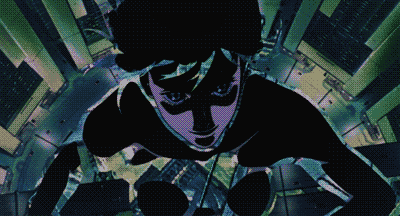
east versus west
So, when I went over the primer to the rise of Cyberpunk earlier, I left something out (on purpose!). During the 80s, there was another prime ingredient to the mix of the nascent genre’s formation: the rise of Japan as a technological leader in the global market. Before World War 2, and indeed, during it, American’s conceptualization of the future, was, well, American. They viewed themselves as the originator of innovation within the world and the blueprint from which the rest of the world should be based. However, this all changed in the post-war era as Japan began to participate in the market, leaving behind their isolationist ways-- suddenly, Japan was what the vision of the future looked like in American imagination-- the Tokyo urban sprawl.
The imagery of Japan is ubiquitous in western Cyberpunk, whether hardcore or or softcore or simply an incidental portrayal of futurism. Disney’s Big Hero 6 features San Fransokyo, San Franciso and Tokyo jammed together complete with neon signs in Japanese letters. During the 90s, Marvel launched Rampage 2099 and Spider-man 2099, both set in glittering neon cityscapes. The series Firefly featured a strange universe in which everyone seems to speak Chinese pidgins (but there’s no Chinese people in the show, funnily). MTV had Aeon Flux, a U.S. take on anime. Even movies like Total Recall borrowed the bright neon flavor. Video games such as Deus Ex and Cyberpunk 2077 feature these influences heavily, with less-bold-but-still-there influence being seen in games like Remember Me and Detroit: Become Human.
There’s an interesting cultural exchange going on between the east and west when it comes to Cyberpunk, as the 90s were rife with cyberpunk fiction in both places-- The U.S. saw The Matrix (which was inspired by Ghost in the Shell, as admitted by the Wachowskis in a phrasing that I find really annoying as an animator: “We want to make that but for real”.), while Japan had the seminal Ghost in the Shell and Akira. It’s interesting to note the stark contrast between western and eastern Cyberpunk-- eastern Cyberpunk misses entirely western Cyberpunk’s detective fiction roots, for one. For two, eastern Cyberpunk tends to concern itself more with philosophical questions about the nature of the soul in relation to technology and deep-seated cultural fears about weapons of mass destruction and government.
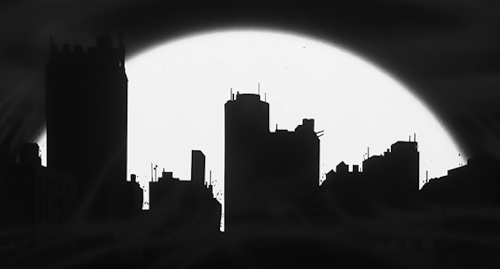
Neuromancer is deeply entrenched in eastern aesthetics-- many Japanese brands are brought up explicitly by name within the model (Mitsubishi, Sony, etc.). Gibson cites the “Kowloon Walled City” of Hong Kong as something that haunted him after he was told about it, and the idea of Coffin Hotels owes quite a lot to it. Gibson is quoted as saying:
“Modern Japan simply was cyberpunk. The Japanese themselves knew it and delighted in it. I remember my first glimpse of Shibuya, when one of the young Tokyo journalists who had taken me there, his face drenched with the light of a thousand media-suns - all that towering, animated crawl of commercial information - said, ‘You see? You see? It is Blade Runner town.' And it was. It so evidently was.“
One of Neuromancer’s primary settings is The Night City, a supposedly gaijin district of Tokyo on the bay-- this...sort of explains why there don’t seem to be a lot of Asian people in Asia, but the issue still stands. This isn’t a game-breakingly “I wouldn’t recommend this book” bad case, but it is something that I felt I should point out. Neuromancer is a foundational work to the genre, which means that not only are its successes carried over, but many of its flaws as well. Now, I don’t want this cricitism to sound like I think William Gibson is a raging bigot or anything-- I really don’t! I follow him on twitter and he’s a perfectly likable guy, actually. Problems aside, I really enjoy his work.
conclusions
Going into the future, I don’t think Cyberpunk is going away anytime soon, and certainly much of it owes its roots to Neuromancer. With shows like Altered Carbon and games like Cyberpunk 2077 on the horizon, I’m interested to see the ways in which our current economic political climate may effect what our vision of a technological dystopia may look like. Cyberpunk is easily one of the most interesting genres of fiction, and if you haven’t looked into it deeply, I highly recommend checking it out.
2 notes
·
View notes
Text
blog 07 - cosmogony
Fellas, are we ready to get dirty? To get completely nasty? To get disgustingly Jungian? Welcome to Hero’s Journey Part 2 Electric Boogaloo!

WOOOOOOOOOOOOOOOOOOOOOOOOOOOO-
preface
I liked this part more than the first part. Before we wade knee deep into some fairly hard to parse ideas, let’s start with a primer on Campbell’s psychoanalytical foundations-- the ideas of Sigmund Freud and Carl Jung.
Freud (🔫) was primarily known for his psychosexual theory, which posited that Everything Comes Back To Dongs; Freud was more or less a gender essentialist and a hardcore Heterosexual Rapscallion, and to him, everything about human psychology looped back around in some way or another to sexuality. He separated the human psyche into three major components: the id, which is the “unconscious” and includes all instinctive urges including procreation, the superego, which is a person’s conscience and learned societal standards that keeps the id in check and makes you feel guilty for sucking, and the ego, which is more or less the middle between the id and superego, represents a person’s realistic ambitions and the “conscious”.
The other big concept of Freudian psychosexuality (besides his developmental theory, which is gross and we won’t talk about it) is the “Oedipal Conflict”The Father figure is the lynchpin of Freudian theory, and acts as the catalyst for the development of children-- for boys, they “compete” with the Father for the Mother’s love and self-actualize through imitation of the Father-- for girls, they’re really down about not having dicks and self-actualize through accepting that they’re breeding stock. You can see some of The Father and The Mother in the Freudian sense pretty readily in Part 1 of Campbell’s works.
Carl Jung was a student of Freud and loyally followed his ideas for many years until the two had a falling out over a number of differences in ideas and personality that sent them on permanently separate paths. Where Freud cut his teeth on his wack psychosexual stuff, Jung primarily concerned himself with the concept of a sort of universality. His conceptualization of the human psyche is similar to Freud’s in some ways, yet differs in one big way: the collective unconscious-- the concept of the inherited, aggregated experience of humanity (sounds familiar to Campbell’s ideas, doesn’t it?).
The through-line of Freud and Jung’s work is more or less a distinctly modernist mindset-- “modern” referring to the school of belief that all things can be studied and understood universally through the scientific method. Campbell ascribes to this same belief, which is the bedrock of his work.
We good? Let’s get to it
01 emanations
“Mythology, in other words, is psychology misread as biography; history, and cosmology.”
from psychology to metaphysics
Following in with Jung’s concept of the collective unconscious, Campbell posits that myths are expressions of our dreams-- of that very same unconscious. However, where dreams are untouchable and uncontrollable, myths can be directly manipulated and given formal shape by our conscious minds. The “universal doctrine” more or less states that Literally Everything is an effect of “ubiquitous” power that both creates and destroys in perpetuity. Myth, then, is an expression of our consciousness’ limited ability to understand the full breadth of the universe’s energy.
the universal round
The universal round is the concept of the cycles in which myth and our existence follow, mirroring that of the cycle between night and day. Our consciousness goes through a cycle of waking experience, dreaming experience, and dreamless sleep, in which we follow our own sort of Hero’s Journey to enlightenment.
out of the void - space
Myths have a sense of “doom” to them, and are innately tragic, yet they also serve towards a sense of fulfillment, as myths cast us in an “immortal” light. This is essentially the beginning of creation myths-- something from nothing.
within space - life
Here, the world becomes “corporeal” and is broken up from “one” into “many”, separated male and female. The Hebrew Zohar explains the idea pretty aptly:
“Each soul and spirit prior to its entering into this world, consists of a male and female united into one being. When it descends on this earth the two parts separate and animate two different bodies. At the time of marriage, the Holy One, blessed be He, who knows all souls and spirits, unites them again as they were before, and they again constitute one body and one soul, forming as it were the right and left of one individual…This union, however, is influenced by the deeds of the man and by the ways in which he walks. If the man is pure and his conduct is pleasing in the sight of God, he is united with that female part of his soul which was his component part prior to his birth.”
the breaking of the one into the manifold
Ole Joey C. calls to attention the primary two modes of myth-- one in which the gods work for the cycle, and one where the gods stand against its progress. The Christian creation myth is a good example of the former, while the story of Marduk and Tiamat is a good example of the latter, in which Marduk slays and dismembers Tiamat, a “female personification of the original abyss itself: chaos as the mother of gods, but now the menace of the world.”, for the sake of mankind’s continuity. Yet Tiamat doesn’t truly die-- everything is created of her “essence”, and so she endures. This is the paradox of myth-- creation is marked by great suffering, and surrounded by harmony-- growth is violent.
folk stories of creation
Simple folk stories could be said to portray the world “as it seems to be” rather than how it is. They tend to tell more straightforward stories, and frequently feature clown characters. These stories are often more playful, and it could be assumed that they aren’t actually believed as much as more proper mythologies. Folk stories don’t seek the meaning of existence of creation, they only observe.
02 the virgin birth
mother universe
Some creation myths involve the passing of energy from the Father Spirit to the Mother Universe, while some myths choose to focus on the maternal rather than the paternal entirely. The Finnish tale of Kalevala is a good example of this.
matrix of destiny (haha matrix)
This is where the mother of creation will appear to humanity in disguise, comprising both birth and death, and accounting for the three steps of the cycle (waking, dreams, sleep)-- in the end, the divine parental figures depart the Earth, leaving humans to figure their shit out on their own.
womb of redemption
Now that mommy and daddy are gone, shit goes sideways for humans with the introduction of ego and vice, and creation in general suffers. Enter our hero-- best example being the virgin birth of Jesus who would go on to bear the sins of humanity and send the cycle on an upward tilt.
03 transformations
the primordial hero and the human
We’re gonna kind of breeze over this part because I have a giant headache from reading in the dark. This is sort of where the divine meets in the middle with humanity and, by extension, actual history. There’s one big example that I’m sure has already come to your mind.

childhood of the hero
While the first entire half of the book detailed the human hero who rises to the occasion, this part is more about the hero as an extension of divine will. He goes through a similar thing, coming to his enlightenment then bringing said enlightenment to the world at large in some way. This hero will usually be held back from achieving true greatness for awhile, and usually possesses some kind of inhuman ability like Herc has his strength. The childhood of the hero ends when he is no longer obscure-- you could even phrase it as when he goes from a zero to a hero.

the hero as the warrior
This part mostly involves a great victory over a big bad monsters, but represents the greater idea of the Hero upending the status quo in some way, freeing the world to move on and to change.
the hero as a lover

The Hero, having overcome whatever, is free to get laid. This comes with its own set of obstacles to overcome and usually involves the lover acting as some kind of mirror to the hero.
the hero as emperor and tyrant
The Hero, as an agent of the Cycle, comes to one of two endings here-- either he is blessed by His Freudian Daddy and takes over as ruler, or he is rejected and loses his divinity, becoming a despotic human tyrant that must be, in turn, overthrown by another hero.
the hero as world redeemer
This is a progression of the emperor bit from the last section-- passing two initiations, first as emissary to his father, then realizing that they are one (wack). This usually is followed by a period of awfulness in which the hero’s human vices wreak some sort of havoc on the world, in which he becomes either a tyrant or a martyr. It’s worth noting that Campbell stresses that these are two ways of telling essentially the same story of the son taking the father’s place.
the hero as a saint
This hero has totally moved beyond self-interest and is one with the wholeness of the universe. Nice!
the departure of the hero
The hero dies or has to leave in some way, stories do always have to end. From Cu Chulainn to Charlemagne, everybody dies (or goes into a plot coma Until They Are Needed Once More).
04 dissolutions
the end of the microcosm
In the end, we are all Spiderman.
the end of the macrocosm
The world has to die just like the hero, also.
0 notes
Text
blog 06 - the matrix

If I sound a little low energy in this post, I have been VERY sick for awhile. Hopefully I can muster some more thoughtful thoughts at a later date, but for right now, I’m going to do a basic Hero’s Journey take on the Matrix.
ordinary world
Neo gets a pretty strong character introduction by way of mise en scene. If you don’t know what mise en scene is, it’s a term literally translated to “sense of the scene” and refers to details placed mindfully in shots in a movie to exposit certain information. A really good example of this is the classic Lynch movie Eraserhead, in which protagonist Harry’s room features a lot of weird stuff, such as a framed picture of a mushroom cloud that suggests why the world in Eraserhead is so terrible, and a withered plant sitting in a pile of dirt without a pot on his nightstand, suggesting that Henry is incapable of supporting other life. It’s a really broad term, but it’s something good to keep in your head when you’re trying to be attentive about your movie viewing.
Neo’s nodded off at his computer desk in a dim, messy room, and there are random news articles on his screen. We immediately establish this way that he is a reclusive computer nerd but also that he has some kind of intense drive that lead him to stay awake so long that he’d pass out on his keyboard.
call to adventure
Trinity baits him on the computer into following the white rabbit to a club where Trinity gives him exposition about Morpheus. It’s nearly as literal a call to adventure as we can get.
refusal of the call
Neo chickens out of the daring skyscraper walk ordered by Morpheus, so that counts as a refusal.
meeting the mentor
In one of the film’s most iconic bits, Neo meets Morpheus in a trippy all-white room with leather armchairs and the infamous blue and red pills. Cool shades, cool trenchcoat. The Matrix has possibly the singular most indulgent aesthetic I’ve ever seen when it comes to costuming, really.
crossing the threshold
Neo wakes up from The Matrix inside a giant pod full of hallucinatory goop.It’s certainly a pretty painful crossing of the threshold. He’s discarded by the alien machines that use humans for batteries, and rescued into a hovercraft.
road of trials
Neo goes through a series of, like, stuff, to test if he’s really The One described by the Oracle or not, and to help him understand the lengths of what he can do to bend reality in the Matrix. He hangs out with the crew on the ship whose name I can neither pronounce nor spell, and he learns more about the agents and red dresses.
innermost cave
I would argue that the innermost cave isn’t him dealing with the agents, but him confronting the Oracle, and by extension, his self-doubt and greatest fears. The Oracle tells him he’s not all he’s chalked up to be and he’s not the chosen one after all.
ordeal
This would be Neo heading back into the Matrix loaded with guns and with Trinity at his side to rescue Morpheus from the dastardly Hugo Weaving.
the reward (seizing the sword)
This would probably be him realizing his bullet time powers, but its followed super immediately by Cypher betraying them, so it’s a really short part of the journey.
the road back
Cypher kills Dozer and wounds Tank and starts unplugging all the fellas in the Matrix-- Tank doesn’t quite let him finish, but Neo’s left alone with all the Agents. Things don’t look good! Which leads into...
resurrection
This part is super literal. Neo tries to flee from the Agents, and they literally shoot him literally dead in an alley, which means he’s literally dead in literal life. It’s at this point that Trinity confesses her (destined?????) love to him and gives him a kissaroo and he comes back to life, proving that fairytales can indeed dream of cyberpunk sheep. He pops back up and pops right through Hugo Weaving.
return with elixir
The elixir could be argued to be Neo’s renewed sense of self confidence, and the proof that he is in fact The One that the Oracle foretold. With him comes a hope for ending the machine domination, and then there’s a bunch of more movies!
0 notes
Audio
46 notes
·
View notes
Text
blog 05 - a nation under our feet

preface
Black Panther: A Nation Under Our Feet’s greatest strength is the writing and passion of Ta-Nehisi Coates, whose enthusiasm for the world and characters of Wakanda bleeds through in every aspect of the story. In our current political climate, the idea of Wakanda-- the unconquered nation, the glimmering ideal of an Africa without the destruction of colonialism-- stands for something much bigger than just a fictional country.
It is because this idea of the nation is so important that the ideas and conflict that A Nation Under Our Feet seeks to tackle are so...well, nerve-wracking to consider from an ideological standpoint. There’s a real tragedy to it, and if handled poorly it could be very harmful-- but Ta-Nehisi Coates is up to the task and then some, weaving a narrative with a great amount of careful consideration that pays the highest dividends to the characterization of King T’challa, who is easily the most standout character in a book full of standout characters.
It’s weird for me to give such glowing praise to something, but I like it when things are good. I’ve struggled over how best to approach a breakdown of the series, but I’m going to try my best.
the orphan-king

The soul of A Nation Under Our Feet is T’challa, the linchpin of the entire book’s conflict and the human heart that beats at the story’s center. It’s important that T’challa is such a strongly written character, as this keeps him from being eclipsed by the idea of the King of Wakanda. A lot of fighting happens in A Nation Under Our Feet over the idea of the King of Wakanda-- it is a position that comes pre-packaged with a certain level of dehumanization in the public eye.
T’challa is a dutiful man, and a caring man-- he doesn’t shy away from hard decisions and will gladly step into the fray even despite his position-- but it is this very willingness to fight that leads to conflict in his duty. He is the Black Panther, the protector of Wakanda, but he is also the King-- in Coates words “Captain America doesn’t have to run a country, Spiderman doesn’t have to run a country...”

In T’challa we see the personal cost of conflict and war-- he’s lost Shuri, and nearly loses Ramonda. He suffers physically and emotionally on the frontlines, and must ultimately undergo a transformation in the Campbellian sense-- the problems in Wakanda are’t problems that he can punch his way out of, and he must ultimately confront the true ideas and philosophy of his enemies, aptly named “The People”. In the end, he must come to understand what the cry “no one man” truly means.

“No one man” is a succinct statement of intent. Issue #1 throws you right into the action with T’Challa, but what follows is a tense situation that introduces Ayo and Aneka, two members of the Dora Milaje who are on the frontlines of the nation’s suffering. What they see in the monarchy is inaction and incompetence-- and when Ramonda sentences them to death for the crime of doing the right thing, they strike out against the government of Wakanda for a greater ideal-- and for its people.

Wakanda is more than a nation-- it is an idea, and it means many different things to many different people. The conflict in Wakanda, over Wakanda, about Wakanda, is ultimately a conflict of ideals before it is a physical conflict. Every primary character in A Nation Under Our Feet symbolizes an idea of what Wakanda is, or should be.
T’challa, the Orphan King, symbolizes the future of a Wakanda in the wake of great tragedy-- in Coates own words, “a country of orphans”. T’challa is mutable, and able to change-- most importantly, he is emotional and human. In that way, Shuri comes to be the Yang to T’challa’s Yin-- Shuri transcends after her time in the Plane of Memory, coming to symbolize everything that Wakanda has meant in the past-- but her transcendence means that she loses humanity-- she is the past, and T’challa is the future.
Ramonda represents order and government in Wakanda, shown in her treatment of Ayo and Aneka-- it wasn’t the morality of their deeds that mattered to her, it was the unlawfulness that mattered. On the other side of that dichotomy are Ayo and Aneka-- forces of moral goodness that operate outside of the law and fighting for Wakanda’s people. A lawless Wakanda would cease to function, but the law can sometimes obstruct true justice in the same stroke.

We see a dichotomy between Changamire, Tetu, and Zenzi as well-- all of them are concerned for Wakanda’s state and wish for a “brighter, better future” in Tetu’s own words, but they symbolize different ideas of this Wakanda. Changamire, while a rebellious man and a proponent of extreme ideas, is ultimately a peaceful soul. Tetu and Zenzi represent the darker side of change-- they’re violent and extremist, and willing to make great sacrifices for the progress of Wakanda. In Coates’ words, The People represent the conflict of personal philosophy versus intellectual ideal-- Changamire abhors violence, but his intellectual ideals are the same as Tetu and Zenzi’s.
No one idea of Wakanda is completely correct-- the ultimate meaning of “no one man”. T’challa alone cannot encompass everything that Wakanda can and must mean to everyone-- in order to mend the divide in his suffering country, he must bring together the often contrary ideals of his people to form a cohesive whole. No one man, and no one ideal can heal Wakanda.

1 note
·
View note
Text
blog 04 - avatar (the one with the blue people not the last airbender)

preface
I went into this with absolutely no feelings about this movie beyond the absurdity of how many sequels it’s apparently going to get. As an artist, I find the visual effects extremely impressive even to this day, but as a storyteller, I thought this story was almost so inoffensive that it’s offensive.
However, I think that engaging with things in good faith is a good way to find ways to expand your horizons and thoughts, and I like to enjoy things despite my dad’s insistence that I like to not enjoy things. (It’s not that I like to not like things, it’s that it’s easier to entertain people when it’s a bad review. Tough crowd.) I’m a firm believer in the idea that cerebral analysis of media adds to the joy of consumption rather than takes away from it, so let’s dive right in.
I like structure, so we’re gonna layer it like a delicious theme cake.
1. the elephant in the room
Everyone has seen Pocohontas. Everyone has seen Dancing With Wolves. I’m not really here to rehash arguments, but I think getting into this movie without addressing what first comes to everyone’s mind when they think about it is pretty much impossible. The “White Savior” trope is more or less a narrative cliche in which a noble white person will take a stand against the Bad White People on the side of a sympathetic oppressed people-- Native Americans see this plotline probably the most, but black people still see it today every now and then (Green Book got nominated for a lot of Oscars, after all. The hunger is there for easily digestible feel-good race relation drama.) Wikipedia sums up the White Savior trope better than I could, so here it is:
“At the cinema, the white savior narrative occupies a psychological niche for most white people, as an expression of their latent desire for interracial goodwill and reconciliation. By presenting stories of racial redemption, involving black people and white people professing to reach across racial barriers, Hollywood is catering to a mostly white audience who believe themselves unfairly victimized by non-white ethnic groups, because they are culturally exhausted with the unfinished national discourse about race and ethnicity in the society of the United States. Hence, films featuring the narrative trope of the white savior have notably similar storylines, which present an ostensibly nobler approach to race relations, but offer psychological refuge and escapism for white Americans seeking to avoid substantive conversations about race, racism, and racial identity. In this way, the narrative trope of the white savior is an important cultural artifact, a device to realize the desire to repair the social and cultural damage wrought by the myths of white supremacy and paternalism, regardless of the inherently racist overtones of the white-savior narrative trope.“
Native Americans factor into this most significantly in the case of Avatar-- aliens in movies are hardly ever just aliens. Whether they represent an oppressed underclass (District 9), childhood innocence (E.T.), or fear of foreign invasion (War of the Worlds), aliens are an easy vessel to carry almost any idea you want them to. So if the Na’vi are more or less an ideological stand-in for Native Americans during the conquest of America, our protagonist Jake is the future space cowboy to the Cowboys and Indians In Space.
Both Jake and Grace sort of fall in and out of the White Savior space-- ultimately Grace condescends to the Na’vi a little more and she has a more complete character arc that ends with her transcending this trope, but Jake is whole hog in it. He’s like, the legendary prophecy warrior. He’s The Guy.

(Pictured above: The Guy)
James Cameron grapples pretty hard with the White Savior trope-- he never truly goes one way or another about it and the concept of Avatars-- as in the Na’vi bodies that Jake and company jump into-- significantly...well, complicates the idea of race relations in this movie. There are certainly some uncomfortable ideas about identity wrapped up in the concept of body swaps (if this idea interests you, Altered Carbon is a really good read), but re: the readings and lectures, the concept kind of works towards what is ultimately the broad takeaway of the movie.
In summary: no, we’re not doing this whole review about White Guilt in Space. Now that that’s out of the way...
2. james cameron predicted late stage capitalism
Imperialism
"The policy of extending the rule or authority of an empire or nation over foreign countries or of acquiring and holding colonies and dependencies."
Avatar is about imperialism. This is as broad and pointed a theme as you can get from a movie that draws such heavy inspiration from Native American and Aboriginal cultures. Interestingly enough, the movie’s futuristic setting goes hand in hand with the commentary about the military and Western Imperialism.
The company in Avatar, and all the almost comedically evil military men, are very brazen about their lack of ideological purpose. They are on Pandora for money. They are being paid to go to Pandora to take its resources-- the delightfully named “Unobtanium” in specific. As mentioned in the reading, Unobtanium is valuable for its properties as a superconductor, and I’m not a STEM kid, so I’ll leave it at that for simplicity’s sake.
That the mercenary force on Pandora is so open about their exploitative intentions draws an interesting parallel to the world of today that’s maybe a touch haunting, considering that Avatar came out some years ago. In politics, at least up until now, you notice the use of a few common euphemisms as smokescreens for more extreme ideas-- for example, the Right’s: “protecting American jobs”.
Protecting American jobs is a euphemism for racism against Mexicans-- it was the most common smokescreen reasoning for the border wall pre-Trumpian politics. Trump and company have since dropped the euphemism all together. The death of a euphemism usually means that the euphemism is no longer culturally or socially required-- you can just come out and say whatever horrible thing you mean. In Avatar’s universe, it’s clear that the political-economic climate has come to a point where they can just say that they’re there to steal the Na’vi’s resources whether they like it or not.
The movie and the lecture both draw specific attention to the parallels the film draws explicitly between military tactics used in the movie, and real-world events. “Shock and Awe”, a tactic coined by the Bush era, is referenced in exact terms-- it being a display of overwhelming force intended to break the fighting spirit of the enemy. The commander character whose name I just read but I can’t remember now says that he is a veteran of both Venezuela and Nigeria-- both real world locations in which the U.S. has invaded and destabilized for material interests under the guise of American ideology.
In Avatar, we see the thin veneer of “freedom and democracy” as the driving forces of U.S. intervention stripped away explicitly. The opening narration of Jake’s arrival to Pandora has him say that “on Earth, these men were soldiers fighting for freedom...but here, they’re mercenaries”, however, the line between a supposed freedom fighter and a mercenary is borderline nonexistent.

3. western scientific objectivism sucks
Another current running through Avatar is the juxtaposition of what is “real” with what is “unreal-- aka Western objectivity science versus belief systems. This is embodied in the character of Grace, a scientist and anthropologist who has been researching Na’vi culture for some time. The reading characterizes her as “the happy face of liberalism” that tries to put a nice coat of paint over the same imperialist ideas that the more blunt military types embody-- she is kinder to the Na’vi and sees their culture and planet as worth preserving, but she is ultimately dismissive of their beliefs and of Eywa (”pagan voodoo”) the same as the other mercenaries.
We’re gonna put on tinfoil hats for a little bit here to make a relation between Western culture (imperialism and colonialism) and capitalism and paganism. Are you ready?
Okay.

So you know how they burned witches at the stake at the onset of the Industrial Age in America and the pagan practices of “hedge magic” were pretty much obliterated? I don’t think that’s a coincidence. Capitalism is a system that can only operate materialistically-- people aren’t “people” but “workers”, and the concept of magic and belief exists in terms that capitalism can’t define, and more importantly, can’t exploit. So witches were burned and women were placed with great reinforcement back into domesticity, where their function in capitalism was to give birth to and rear new workers.
You can see this dichotomy between the science of objectivity (what is “real”) and belief systems (what is “unprovable”, “unobservable”) in the way Grace uses scientific terms to justify the Na’vi’s spirituality. A very powerful through-line can be seen in the way that imperialism, capitalism, materialism, and objective science intersect. Their interconnected natural collective consciousness is like the raw function of a brain to her, likened to a network. It isn’t until Grace is mortally wounded and experiences the Na’vi’s healing ceremony that she is able to transcend the capitalistic, materialistic terms for definition for Eywa to have a spiritual experience, and to become one with Eywa herself (”she’s real.”)
In a plot that hinges on the material (Unobtainium) interests of a capitalist mercenary force, the ultimate refutation of this is the Na’vi’s spiritual values.
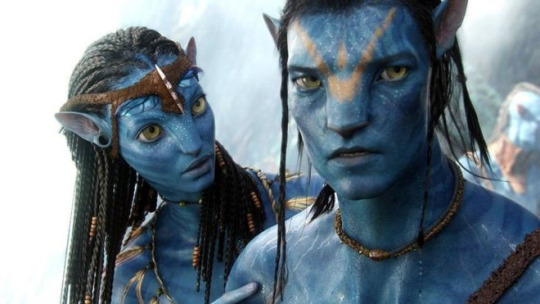
4. avatar: endgame
So what is this all working towards? Well, the idea of an interconnected spirituality like Eywa. The idea takes root in geomantic ideas, more commonly known as “feng shui”-- it’s sort of the concept of an earthly energy, a flow that moves through and connects the Earth and its people and creatures. The strange braid cord things that allow the Na’vi to interface with certain points and other creatures is a very straightforward metaphor for that concept of feng shui and geomancy.
Here we come back around to the concept of Jake as the White Savior/chosen one/The Guy. It’s kind of obtuse, but the general theory is that Eywa chose Jake as a sign that all peoples must needs transcend their boundaries and become one with the larger concept that Eywa represents. This of course comes packaged with an urgent environmental message-- our life is that of the planet, and to exploit and sacrifice one is to sacrifice the other.
Pandora, Eywa, and the Na’vi represent the polar opposite of everything that capitalist imperialism is. Thus, James Cameron, ironically, used a huge budget Hollywood endeavor to refute everything that Hollywood is. Now he’s making Alita: Battle Angel.
Funny how that works. Oh, I made myself sad.
3 notes
·
View notes

